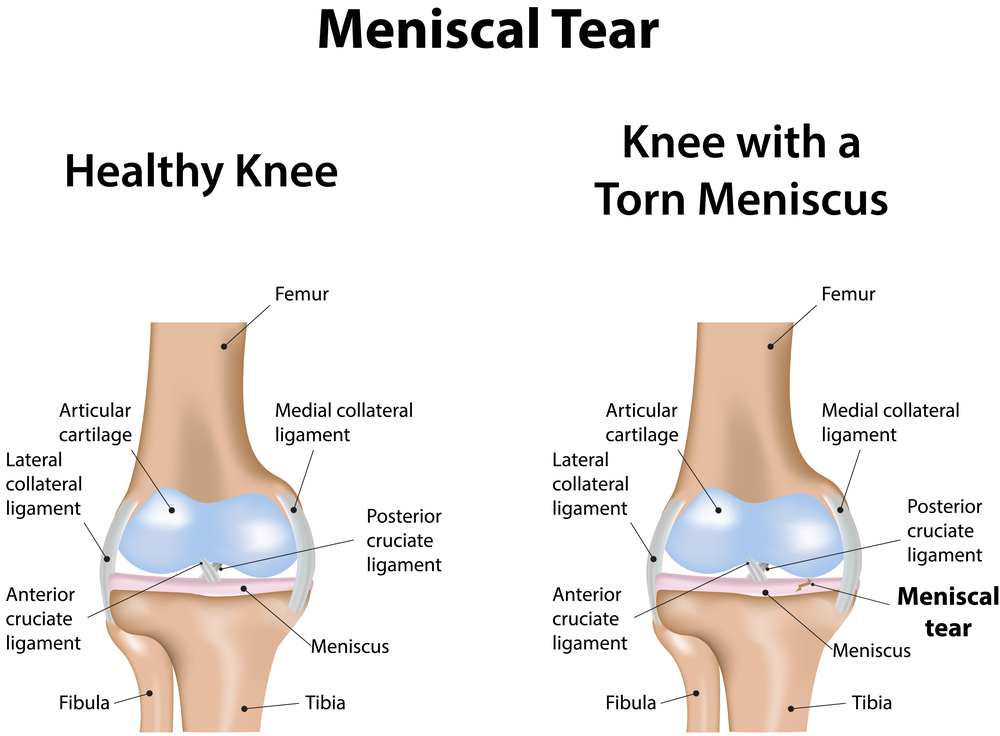Everything you need to know about the torn meniscus: cause, surgery, treatment & exercises
A small or large crack in one of the menisci is a common knee injury. These are two loose pieces of cartilage in the form of an orange disc. They are located on the inside and outside of the knee. The main symptoms of a torn meniscus are: pain and edema in the knee.

Click to enlarge
What is the function of a meniscus?
These cartilage discs act as a kind of shock absorber. When weight is put on one leg, the menisci diverge out. Just think of a ball you step on with your foot. It gets flatter and differs out. This mechanism ensures that forces that are directed downwards are converted sideward to some extent. The pressure is distributed evenly over the knee joint. In addition, the menisci make sure that joint fluid is spread well over the moving parts of the knee.
How can the meniscus rupture?
At the inner and outer meniscus, great forces are exercised during movement. As a result, this cartilage is very vulnerable. With a powerful turning motion – for example in sports, work or in case of an accident – the pressure becomes so large that a small or large rupture may occur in the meniscus. In most cases, the meniscus is damaged on the inside. Most meniscus lesions occur during sports. This is also called the “football knee”.
A meniscus can also tear due to wear of this cartilage. This is called degenerative meniscus injury, but is actually a form of osteoarthritis and the chance acquiring it increases with age. Because the elasticity of the cartilage has decreased, it can also tear without turning. This form of meniscus injury can also be caused by prolonged and continuous knee overload.
What are the symptoms of a torn meniscus?
Tearing the meniscus can be very painful. Injury of the inner meniscus causes pain on the inside of the knee. If the outer meniscus is torn, the pain is felt on the outside of the knee. Usually there is edema, which causes the joint to get thicker. This swelling can also hurt. It may prevent to break a piece of cartilage from the damaged meniscus. This cartilage fragment may then become clamped in the joint. The knee can then get ‘locked’: you cannot stretch or bend your leg. This may happen at the time of meniscus injury, but also later in time.
How is a ‘torn meniscus’ diagnosed?
Immediately after the meniscus has ruptured, it is difficult for a physician to determine what is exactly damaged. The swelling and pain can also be due to another injury, such as damaged knee ligaments or arthritis of the knee joint. Only after a week the knee can be more easily investigated based on the nature of the symptoms. The story of the patient is then an important guide for the doctor and subsequently he will examine the knee. He will check whether there is pressure on the joint gap. On an X-ray, on which only bone can be seen, the meniscus is not visible because it consists of cartilage. However, such a photo is useful to exclude other injuries or conditions. An MRI scan visualizes the inside of your knee including the soft tissue. The doctor can judge the meniscus based on this scan.
How is a torn meniscus treated?
The meniscus can heal itself within a few months. The condition is that you are still young and that the meniscus is well perfused. In order to promote recovery, it is important to avoid kneeling and squatting. A screening operation (arthroscopy) is opted for when the symptoms persist and / or when the knee is locked.
How is a torn meniscus surgically treated?
There are three types of endoscopic operations possible with a torn meniscus.
With a small rupture at the edge of the meniscus, only the scar tissue is cleaned. This stimulates recovery of damage.
In case of a complex tear, the damaged part of the meniscus is removed. The intact part remains behind to maintain an intact function of the meniscus as much as possible.
An unstable rupture at the edge of the meniscus can be re-attached during an endoscopic operation.
Another possibility is to pierce holes in the cartilage to improve blood flow and to stimulate recovery. This is called trephanation.
These treatments are aimed at curing the meniscus injury. The complete meniscus will only be removed when there are no other options. Such a drastic surgery can cause osteoarthritis of the knee after ten to fifteen years.

Share this page
Tweet

Download for free the booklet ‘Moving without pain’ with a retail value of $6.75 / £4.95.
Any questions? Please feel free to contact us. Contact us.






